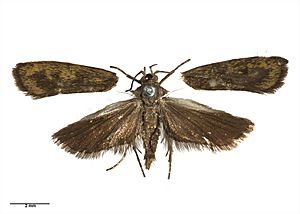Hierodoris atychioides facts for kids
Quick facts for kids Hierodoris atychioides |
|
|---|---|
 |
|
| Scientific classification | |
| Kingdom: | |
| Phylum: | |
| Class: | |
| Order: | |
| Family: |
Oecophoridae
|
| Genus: | |
| Species: |
H. atychioides
|
| Binomial name | |
| Hierodoris atychioides (Butler, 1877)
|
|
| Synonyms | |
|
|
Hierodoris atychioides is a type of moth that lives in New Zealand. It's part of a moth family called Oecophoridae. A scientist named Arthur Gardiner Butler first described this moth in 1877. You can find it in many parts of New Zealand, even on Stewart Island.
What Does This Moth Look Like?
This moth is quite small. Its wingspan (how wide it is with its wings open) is about 14 to 20 millimeters. That's roughly the size of a small coin! Its front wings are mostly blackish-brown. But they also have tiny scales that can be whitish, cream, light brown, or even reddish-brown. The back wings are a darker brown color.
Life Cycle: What Do the Larvae Eat?
The young moths, called larvae (or caterpillars), eat leaves from many different trees and shrubs. They enjoy plants like Dacrydium cupressinum, Prumnopitys taxifolia, Dacrycarpus dacrydioides, and Libocedrus bidwillii. They also feed on Cupressus macrocarpa, Leptospermum scoparium, Kunzea ericoides, and Ozothamnus leptophyllus. Even some types of Abies, Picea, Pinus, and Thuja are on their menu.
These larvae are very clever! They build special shelters called "spinnings." These spinnings are made from silk, mixed with their waste (called frass) and bits of leaves. The larvae are also gregarious, which means they like to live in groups. You can often find many larvae living together in just one spinning!
Images for kids





